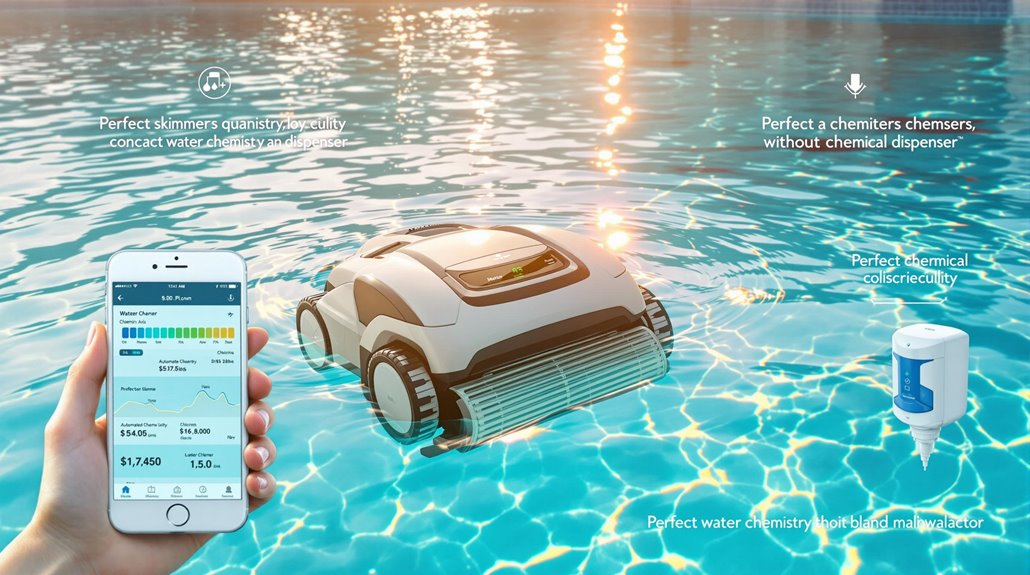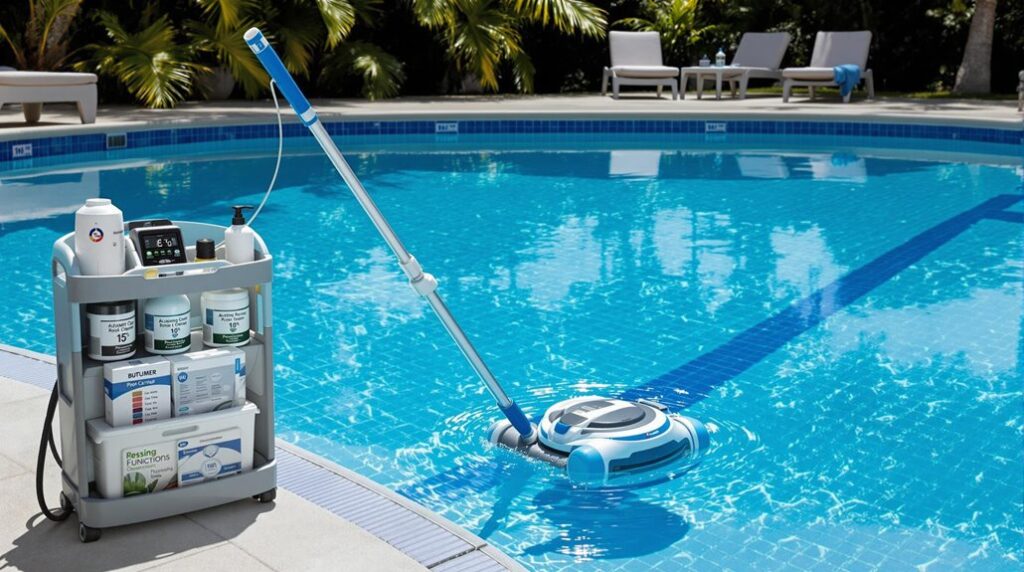You can maintain a sparkling pool with minimal effort by combining smart technology and simple daily habits. Install automated sensors to monitor water quality and adjust chemical levels, while robotic cleaners handle the physical work. Implement quick daily routines such as skimming and using oil-absorbing tennis balls in your skimmer. Keep pH levels between 7.2-7.8, and run your pump 10-12 hours daily. Smart pool innovations and modern maintenance techniques offer even more ways to simplify your pool care.
Smart Pool Tech: Your New Best Friend

Three major innovations in pool technology have transformed maintenance from a tedious chore into a streamlined, automated process. Smart sensors now monitor your water quality in real-time, automatically adjusting chemical levels and sending alerts to your phone whenever something’s off balance. Robotic cleaners navigate your pool’s surface independently, scrubbing walls and floors while collecting debris without any effort on your part. Year-round pool safety requires consistent monitoring and maintenance to protect swimmers and equipment alike. If your pump starts making unusual noises, checking for trapped air bubbles can prevent more serious mechanical issues. Daily skimming helps prevent debris from sinking and creating bigger cleaning challenges.
You’ll love how easily you can control everything through your smartphone, from adjusting the temperature to scheduling cleaning cycles. The system’s weather-responsive features even adapt to environmental changes, reducing energy consumption by up to 30% through smart pump technology. Pool heater inspections should be performed monthly to prevent system inefficiencies and extend equipment life. With automated covers, customizable lighting, and integrated maintenance logs, you’re free to enjoy your pool instead of constantly maintaining it. Regular filter maintenance checks can significantly extend your pool equipment’s lifespan while maintaining optimal water clarity.
Daily Quick-Win Routines That Make a Big Impact
While smart technology transforms pool maintenance, you’ll still need a few hands-on routines to keep your water crystal clear. These daily quick-wins will drastically reduce your maintenance time while maximizing results.
Modern pool care blends smart tech with essential manual tasks – it’s the daily habits that create a truly sparkling oasis.
- Start with a thorough surface skim using a basket or window screen, then immediately empty the debris to prevent it from re-entering the pool
- Deploy oil-absorbing tennis balls in your skimmer to combat sunscreen residue
- Spot-scrub visible algae at a 45-degree angle using a nylon brush, focusing on corners and steps
- Monitor filter pressure daily, aiming for 8-15 psi, and maintain a 10-12 hour pump runtime
Don’t forget to wipe pool edges with a microfiber cloth during your skimming routine – this simple step prevents dust buildup and keeps your pool looking pristine.
Water Chemistry Made Simple

Perfect pool chemistry doesn’t need to be complicated, even though managing your water’s chemical balance might seem intimidating at the outset. You’ll master it quickly by focusing on two key factors: pH and total alkalinity (TA).
Your pH should stay between 7.2 and 7.8 to protect both swimmers and equipment. Whenever it’s too low, add soda ash to raise it. Whenever it’s too high, use muriatic acid or dry acid to lower it. For TA, maintain levels between 80-120 ppm, since it acts as your pool’s chemical buffer. Without proper TA, you’ll face constant pH fluctuations. If you’re tired of manual testing, consider installing a smart monitor – it’ll alert you whenever your water needs attention, making maintenance practically effortless. Pool shocking treatment should be performed weekly during peak swimming season to eliminate contaminants and maintain water clarity. Regular algae prevention includes maintaining proper chemical levels and ensuring adequate circulation. Testing your pool’s pH levels weekly is essential for maintaining crystal clear water that’s safe for swimming. If your chemical tests fail, systematic troubleshooting can help identify and resolve issues quickly. When your pool water turns cloudy, proper filtration is often the first step to restoring clarity.
Year-Round Pool Care Without the Hassle
Maintaining a pristine pool doesn’t need to be a year-round burden whenever you’ve got the right systems in place. By combining smart equipment choices with seasonal adaptations, you’ll create an efficient maintenance routine that practically runs itself. Regular tile brushing helps prevent calcium buildup and keeps your pool surfaces looking pristine.
Salt chlorination systems offer a gentler sanitizing approach compared to traditional chlorine pools.
Regular monitoring of water level changes can help detect potential leaks before they become major issues.
Here’s your streamlined approach to year-round pool care:
- Install a salt chlorinator and skimmer socks to reduce chemical handling and filter maintenance
- Deploy dual-cover systems – solar covers for summer heat retention and rigid covers for winter protection
- Run your pump 12+ hours in summer, scaling back to 4-6 hours during mild winters
- Set up monthly equipment checks for seals, O-rings, and pressure levels
With these automated solutions, you’ll spend less time managing your pool and more time enjoying it, while your circulation and filtration systems handle the heavy lifting. Starting your pool preparation checklist early in spring ensures a smooth transition into the summer swimming season.
Frequently Asked Questions
How Long Should I Wait to Swim After Adding Pool Chemicals?
Wait 4 hours after liquid chlorine. Other chemicals (pH adjusters, clarifiers, algaecides): 15-60 minutes.
Can I Use Household Bleach Instead of Pool Chlorine?
Regular bleach works at 2-3x higher volume. Pool chlorine has higher concentration + stabilizers. Pool chlorine is more efficient.
Why Does My Pool Water Turn Green After Heavy Rain?
Pool water turns green after rain due to diluted chlorine levels and introduced phosphates, debris, and contaminants that promote algae growth. Chemical rebalancing restores clarity.
What’s the Best Way to Remove Stubborn Calcium Deposits?
Scrub with pumice stone. Apply diluted muriatic acid. Wear safety gear. Keep surfaces wet during scrubbing.
How Can I Lower My Pool Maintenance Costs During Off-Season Months?
Use a quality winter pool cover, run filters during off-peak hours, and apply algaecide before covering. Invest in winter-specific covers to prevent freeze damage.

